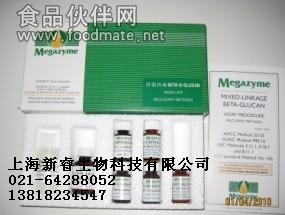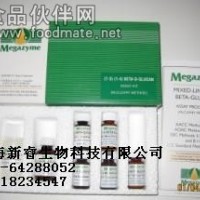
包装:3玻璃瓶+2塑料瓶
在水中的溶解度:易溶大部分
pH值:中性
气味:无
形态:粉末和液体。
保存:10年以上(冰箱)
成分:
名称 比例
Lichenase 1瓶(玻璃)
β-葡萄糖苷酶 1瓶(玻璃)
葡萄糖标准溶液 1瓶(玻璃)
大麦控制面粉 1瓶(塑料)
燕麦控制面粉 1瓶(塑料)
葡萄糖测定试剂 1瓶(玻璃)
葡萄糖试剂缓冲 1瓶(聚丙烯)
AACC Method 32-23, EBC Methods 3.11.1, 4.16.1 and 8.11.1, AOAC Method 995.16, ICC Standard No. 166 and RACI standard method for the measurement of 1,3:1,4-ß-D-glucan in cereal grains, milling fractions, wort and beer. Recommended/Standard procedure of the Association of Official Analytical Chemists (AOAC), American Association of Cereal Chemists (AACC), Royal Australian Chemical Institute (RACI), European Brewing Convention (EBC), and International Association for Cereal Science and Technology (ICC).
Catalogue Number: K-BGLU
Content: 100 assays per kit
Appearance Three glass vials plus two plastic vials.
Specific Gravity Not applicable
Solubility in Water Most components readily soluble.
pH Value neutral
Odour none
Form Powders and liquid.
Stability stable in a refrigerator for ten or more years
Ingredients Name CAS Proportion
Lichenase 1 vial (glass)
b-Glucosidase 1 vial (glass)
Glucose Standard solution 1 vial (glass)
Barley Control Flour 1 vial (plastic)
Oat Control Flour 1 vial (plastic)
Glucose Determination reagent 1 vial (glass)
Glucose Reagent Buffer 1 vial (polypropylene)
SPECIFICITY:
The assay is specific for mixed-
KITS:
Kits suitable for performing 100 assays are available from Megazyme.
The kits contain the full assay method plus:
Bottle 1: Lichenase [specific, endo-(1-3)(1-4)-b-D-glucan
4-glucanohydrolase] suspension (1 mL, 1,000 U/mL).
Stable for > 3 years at 4°C.
Bottle 2: b-Glucosidase (1 mL, 40 U/mL) suspension.
Stable for > 3 years at 4°C.
Bottle 3: GOPOD Reagent Buffer. Potassium phosphate
buffer (1 M, pH 7.4), p-hydroxybenzoic acid (0.22 M)
and sodium azide (0.4 % w/w). Stable for > 3 years
at 4°C.
1
Bottle 4: GOPOD Reagent Enzymes. Glucose oxidase
(> 12,000 U) plus peroxidase (> 650 U) and
4-aminoantipyrine (80 mg). Freeze-dried powder.
Stable for > 5 years at -20°C.
Bottle 5: D-Glucose standard solution (5 mL, 1.0 mg/mL) in
0.2 % (w/v) benzoic acid.
Stable for > 5 years at room temperature.
Bottle 6: Standardised barley flour control. b-Glucan content
shown on vial label.
Stable for > 5 years at room temperature.
Bottle 7: Standardised oat flour control. b-Glucan content
shown on vial label.
Stable for > 5 years at room temperature.
PREPARATION OF REAGENT SOLUTIONS/SUSPENSIONS:
1. Dilute the contents of bottle 1 (lichenase) to 20.0 mL with
20 mM sodium phosphate buffer (pH 6.5). Divide into
appropriately sized aliquots and store in polypropylene tubes at
-20°C between use and keep cool during use if possible.
Stable for > 2 years at -20°C.
2
2. Dilute the entire contents of bottle 2 (b-glucosidase) to
20.0 mL with 50 mM sodium acetate buffer (pH 4.0). Divide
into appropriately sized aliquots and store in polypropylene
tubes at -20°C between use and keep cool during use if
possible. Stable for > 2 years at -20°C.
3. Dilute the contents of bottle 3 (GOPOD Reagent Buffer) to
1 L with distilled water. Use immediately.
NOTE: It is imperative that the lichenase is not crosscontaminated
with b-glucosidase.
4. Dissolve the contents of bottle 4 in 20 mL of solution 3
and quantitatively transfer this to the bottle containing the
remainder of solution 3. Cover this bottle with aluminium
NOTE:
1. If the concentrated buffer is stored at -20°C, it will form salt
crystals that must be completely dissolved when this buffer is
diluted to 1 L with distilled water.
2. This buffer contains 0.4 % (w/v) sodium azide. This is a
poisonous chemical and should be treated accordingly.
foil to protect the enclosed reagent from light. This is
Glucose Determination Reagent (GOPOD Reagent).
Stable for ~ 3 months at 2-5°C or > 12 months at -20°C.
If this reagent is to be stored in the frozen state, preferably it
should be divide into aliquots that should be freeze/thawed
only once during use.
When the reagent is freshly prepared it may be light yellow
or light pink in colour. It will develop a stronger pink
colour over 2-3 months at 4°C. The absorbance of this
solution should be less than 0.05 when read against distilled
water.
BUFFERS (NOT SUPPLIED):
1. Sodium phosphate buffer (20 mM, pH 6.5)
Dissolve 3.12 g of sodium dihydrogen orthophosphate dihydrate
(NaH2PO4.2H2O) in 900 mL of distilled water and adjust the
pH to 6.5 by the addition of 100 mM sodium hydroxide (4 g/L)
[approx. 50 mL is required]. Adjust the volume to 1 L. Add 0.2 g
of sodium azide. Stable for 2 months at 4°C.
2. Sodium acetate buffer (50 mM, pH 4.0)
Add 2.9 mL of glacial acetic acid to 900 mL of distilled water.
Adjust to pH 4.0 by the addition of 1 M sodium hydroxide
solution. Adjust the volume to 1 L. Add 0.2 g sodium azide.
Stable for 2 months at 4°C.
3. Sodium acetate buffer (200 mM, pH 4.0)
Add 11.6 mL of glacial acetic acid to 900 mL of distilled water.
Adjust to pH 4.0 by the addition of 1 M sodium hydroxide
solution. Adjust the volume to 1 L. Add 0.2 g sodium azide.
Stable for 2 months at 4°C.
EQUIPMENT (RECOMMENDED):
1. Polypropylene tubes/containers with caps (35.0 mL capacity).
2. Glass test-tubes (12 mL capacity).
3. Micro-pipettors, e.g. Gilson Pipetman® (100 μL and 200 μL).
4. Positive displacement pipettor e.g. Eppendorf Multipette®
- with 5.0 mL Combitip® (to dispense 0.1 mL aliquots of
buffer and buffered b-glucosidase solution).
3
5. Adjustable-volume 0-5.0 mL (for phosphate buffer).
dispensers 3.0 mL (for glucose oxidase/
peroxidase reagent).
0-25.0 mL (for distilled water).
6. Laboratory oven.
7. Analytical and top-pan balances.
8. Spectrophotometer set at 510 nm (see point 1 under Useful Hints).
9. Vortex mixer.
10. Thermostated water bath set at 40°C (or 50°C for
the Streamlined Method as detailed on pages 10-13).
11. Stop watch.
12. Whatman No. 41 filter circles.
13. Centrifuge (in conjunction with preparation of malt,wort and beer).
14. Laboratory mill with 0.5 mm screen (e.g. Frisch pulverisette 14®).
15. Boiling water bath.
ConTROLS AND PRECAUTIONS:
1. With each set of determinations, reagent blanks and D-glucose
standards of 50 μg and/or 100 μg are included, in duplicate.
The reagent blank comprises 0.1 mL distilled water + 0.1 mL
sodium acetate buffer + 3.0 mL of GOPOD Reagent
The glucose standards comprises 0.1 mL sodium acetate
buffer + 0.1 mL D-glucose standard (50 μg/0.1 mL or 100 μg/0.1
mL) + 3.0 mL GOPOD Reagent
2. With each set of determinations at least one standard barley
flour is also included.
3. With each new batch of GOPOD Reagent the time for
maximum colour formation with 100 μg of D-glucose standard
should be checked. This is usually approx. 15 min.
4. It is imperative that the lichenase enzyme preparation
is not cross-contaminated with the b-glucosidase
preparation (the reverse is not a problem).





